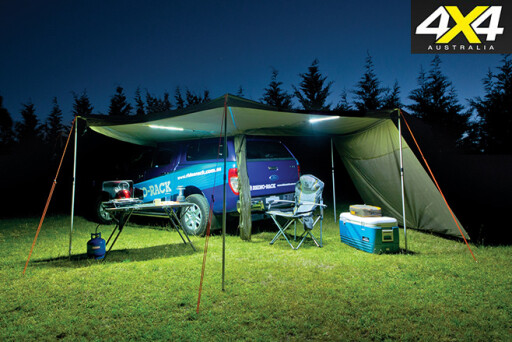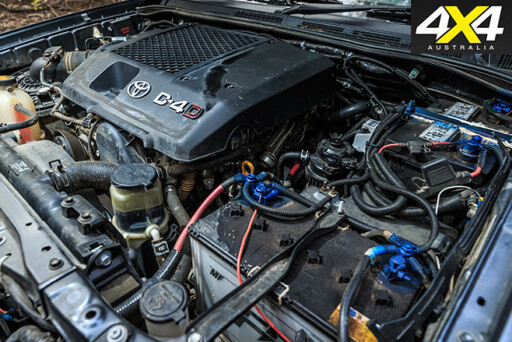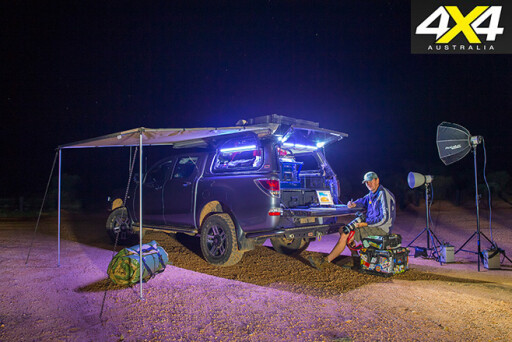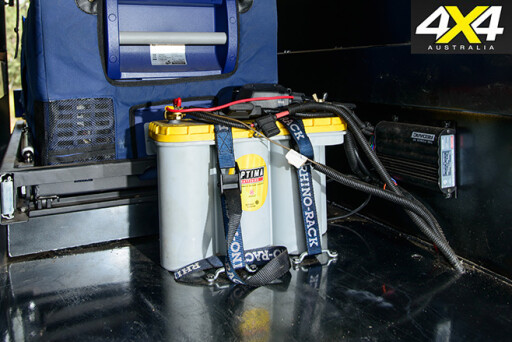.jpg )
Few things in life are more satisfying than reaching into your vehicle’s 12V fridge to pull out an icy-cold drink while witnessing a stunning sunset in the middle of nowhere.
To power that fridge – plus lights and other accessories – when you’re camping, as well as start your vehicle the next day, you rely on one or two little boxes of magic: your vehicle’s batteries. But different accessories, and the needs of the vehicle itself, mean there are different types of batteries designed and constructed for different tasks...
BATTERY BASICS
A battery works by converting chemical energy to electrical energy. The most simple – and most common – vehicle battery design is the flooded wet-cell battery. In this design, a series of metal plates are immersed in liquid acid (the electrolyte) and connected to two terminals, which provide a connection to the vehicle’s electrical system.

A chemical reaction between the plates and the electrolyte results in power that can start the vehicle and run its accessories. The beautiful part of all this is that the chemical reaction is reversible. Going one way, electrical energy is made available to make stuff (lights, fridges) work.
Going the other way, the application of electrical energy to the battery (from the vehicle’s alternator – a battery charger that plugs into your house supply – or from a solar panel) results in the chemical reaction being reversed. Through this process the battery is recharged and ready to go again.
 Fully charged, a conventional lead-acid battery (most batteries rely on lead as the main ingredient of its plates) will show a voltage of around 12.6V. The vehicle’s alternator will generally provide current somewhere in the range of 13.6 to 14.0V; sometimes a little more. It’s this increased voltage from the alternator that provides the pressure (to put it simply) to charge the battery. This voltage – from the battery or from the alternator when the engine is running – provides the force to operate the vehicle’s other electrical devices, too.
Fully charged, a conventional lead-acid battery (most batteries rely on lead as the main ingredient of its plates) will show a voltage of around 12.6V. The vehicle’s alternator will generally provide current somewhere in the range of 13.6 to 14.0V; sometimes a little more. It’s this increased voltage from the alternator that provides the pressure (to put it simply) to charge the battery. This voltage – from the battery or from the alternator when the engine is running – provides the force to operate the vehicle’s other electrical devices, too.
Usually, your vehicle battery’s first job of the day is to provide power to unlock the doors and then start the vehicle’s engine. However, only a small amount of oomph is needed to unlock a set of door locks, while the starter motor needs several horsepower to turn over the engine, especially a diesel engine on a cold morning. It’s easy to see that these two tasks have wildly varying power needs.

The basic lead-acid chemistry principle remains similar; however, differences in internal manufacturing technology provide different performance and durability characteristics. In other words, some batteries are better suited than others for providing power for particular jobs in a vehicle.
GETTING STARTED
Starting batteries (sometimes referred to as an SLI: starting/lighting/ignition) are designed for starting vehicles. These batteries are good at delivering a big burst of energy for only a few seconds. A starting battery contains thin lead plates and is typically of flooded wet-cell construction.
 Because the plates are thin, more of them can fit inside the battery, which means more surface area is exposed to the electrolyte. This extra exposure allows the energetic chemical reaction needed to produce a sudden jolt of starting power.
Because the plates are thin, more of them can fit inside the battery, which means more surface area is exposed to the electrolyte. This extra exposure allows the energetic chemical reaction needed to produce a sudden jolt of starting power.
In service, the energy lost during starting is topped up straight away by the engine’s alternator, which also provides the power to the vehicle’s electrical accessories. In most vehicles, the battery doesn’t provide much – if any – power while the vehicle is being driven.
There’s a catch for 4x4 owners, though. Without going all white-coat and propeller-head with the chemistry, starter batteries generally don’t like being worked too hard – or, discharged too far – as it damages the internals and shortens the life of the battery. Discharge (or flatten) a conventional starting battery too far, too often – possibly as little as five times – and, chances are, you’ll kill it.
GOING DEEPER
Deep-cycle batteries offer different performance that usually makes them more suitable for second-battery use in 4x4 and camping situations. Rather than needing to smack a starter motor with a jolt of power, deep-cycle batteries are designed to spoon out power over a substantially longer period of time.
 In the context of battery tech, a cycle refers to a usage pattern whereby a battery draws on its charge reserves to power an accessory before the battery is recharged by a vehicle alternator or some other source of charge. Deep-cycle batteries can provide more power than starting batteries without permanent damage. In other words, they can be cycled deeper – hence the name.
In the context of battery tech, a cycle refers to a usage pattern whereby a battery draws on its charge reserves to power an accessory before the battery is recharged by a vehicle alternator or some other source of charge. Deep-cycle batteries can provide more power than starting batteries without permanent damage. In other words, they can be cycled deeper – hence the name.
This deep-cycle ability is due, in part, to thicker internal plates that don’t degrade as quickly with repeated deep-cycling (discharging) of the battery.
Deep-cycle batteries tolerate starting duties far better than starter batteries tolerate deep-cycling. But, size-for-size, you can’t match a starter battery’s ability to provide quick hits of power to crank a starter motor.
BETTER ALL-ROUND
Different plate technology within the battery – using different materials and construction techniques – can increase performance of both starter and deep-cycle batteries.
According to Century Yuasa Batteries (who assisted with this article), alloys of antinomy can make a deep-cycle battery better: it can have a longer service life; a superior cycle life; and can perform better in hot conditions.
Alloys of calcium enhance starter/SLI battery performance with higher cold cranking amps, quicker recharge and a longer shelf life. And yes, it’s possible to create a hybrid battery using both antinomy and calcium.

Blend the best performance/power delivery characteristics of starting and deep-cycle batteries and you have what is often referred to as an all-rounder battery. These are particularly relevant for four-wheel drives and other vehicles used for camping and touring, as they offer the best of both worlds: they cope with starting and the engine-off powering of accessories such as fridges for extended periods of time.
They’re usually built stronger, too. Like marine batteries, the internals are better-anchored into a tougher case to survive vibrations and rough movements.
ABSORBED GLASS MAT (AGM)
This refers to the construction technique rather than the output performance of the battery. But, because AGM is a buzz-word in the 4x4 world, we’ll take a quick look at it.
AGM batteries hold the electrolyte (acid) in a layer of fibreglass matting between the plates. During manufacture, the plates are pressed together with the glass mat to create a very sturdy matrix before the electrolyte is introduced and the battery sealed. This makes the battery just about spill-proof and more durable – performance-wise and mechanically. Because AGM batteries typically carry slightly bigger plates in the same sized box, they can usually deliver a corresponding increase in cranking grunt and recharge quicker when depleted (if the charging system is up to the task) than a similar-sized wet-cell battery.
 Deep-cycle batteries for automotive use are often AGM construction, too, and there is a move towards AGM for starting/SLI in later-model cars fitted with lots of electrical equipment.
Deep-cycle batteries for automotive use are often AGM construction, too, and there is a move towards AGM for starting/SLI in later-model cars fitted with lots of electrical equipment.
Being sealed – and hence maintenance-free – AGM batteries can’t be topped-up like flooded wet-cell batteries. Therefore, they don’t like under-bonnet heat (anything above around 45C can be a problem as it causes fluid loss), which is why in later-model cars – and smart aftermarket 4x4 installations – they are usually installed in the cabin or boot rather than the engine bay.
GEL CELLS
Gel cells also hold the electrolyte secure rather than have it present in the battery as a liquid. This holding medium is silica, which results in a jelly-like layer between the plates. Gel cells can tolerate deeper discharges and more of them, and most are used primarily for deep-cycle. Using the silica gel construction for quick hits of power – which is the type of power a flooded wet-cell starting battery is good for – causes damage in the gel. Like AGMs, gels are maintenance-free, so they can’t be topped up and require a comfier environment to give their best.
THE NEXT BIG THING?
In the past couple of decades, battery technology has been largely moved forward by the laptop and mobile-phone markets – and, to some extent, hybrid cars – where power output from a lightweight source is a significant requirement. This tech has filtered to the car and camping scenes. Chemically, lithium batteries are a new ball game, compared to lead-acid batteries.
Batteries that use lithium chemistry (such as lithium phosphate) offer similar outputs, but with less weight than conventional lead-acid (wet-cell, AGM or gel) batteries. This lighter weight is significant when many batteries are needed – plenty of weight can be saved – in, for instance, a hybrid car.
 Sure, the weight of one battery doesn’t make much difference in a 2.5-tonne 4x4 tourer. But lithium batteries are suited to vehicle-based deep-cycle installations as they tolerate deep discharge (approaching 90 per cent) while displaying life expectancy of several thousand cycles. This deep-discharge ability (think of it as an extended operating range) means the battery installation can be down-sized and meet the same level of performance for equipment and accessories.
Sure, the weight of one battery doesn’t make much difference in a 2.5-tonne 4x4 tourer. But lithium batteries are suited to vehicle-based deep-cycle installations as they tolerate deep discharge (approaching 90 per cent) while displaying life expectancy of several thousand cycles. This deep-discharge ability (think of it as an extended operating range) means the battery installation can be down-sized and meet the same level of performance for equipment and accessories.
There are other benefits, too. Lithium batteries offer a higher, more stable voltage when used under load and over the discharge cycle, and they tolerate storage when partially charged. Being of dry construction, they are also spill-proof and maintenance-free.
They do, however, require a stricter charging regime, and they aren’t cheap – they cost about five times as much as a similar-capacity lead/acid battery.
IS IT CHARGED?
A fully charged lead-acid battery will typically show a voltage from around 12.6V to 12.7V, while a flat battery will have 10.5V or less (even though there is measurable voltage there, it’s too weak to get out of its own way because of the way the chemistry works).
Voltages in between can give a guide to the remaining charge in a battery. These numbers are determined by the lead-acid chemistry, so really can’t be changed or tweaked (or fibbed about). Due to the chemical, rather than mechanical, nature of batteries, these voltages are approximates only, so any claims such as, “it’s only 80 per cent charged” or “has 50 per cent capacity” are approximations and are influenced by conditions such as temperature and age.
 A battery with a voltage of around 12.1V is regarded as 50 per cent charged, which is a safe and sensible discharge limit for a vehicle-starting battery. Deep cycles can cope with being pulled down to 80 per cent; but, in general, the less charge pulled out of a battery each cycle, the greater the number of cycles its life will have.
A battery with a voltage of around 12.1V is regarded as 50 per cent charged, which is a safe and sensible discharge limit for a vehicle-starting battery. Deep cycles can cope with being pulled down to 80 per cent; but, in general, the less charge pulled out of a battery each cycle, the greater the number of cycles its life will have.
WHAT KILLS A BATTERY?
Operating a battery beyond what it’s designed to do – asking it to deliver more current than it’s specified for, or discharging it too deeply – will shorten its life.
No matter what type of battery, leaving it discharged for any length of time causes sulfation; a situation which quickly clogs and kills a battery. Batteries that are seldom used – for instance, those fitted to classic vehicles or camper trailers – should be stored fully charged and given a recharge every month or so.
 A three- or multi-stage charger (with a storage/maintenance mode) can be used to keep batteries in top shape, ready for the next adventure. Typical float chargers will maintain the voltage at the battery terminals at a little over 13V; many batteries have charging requirements listed in their specs. Conventional old-school chargers intended solely for flooded wet-cell batteries are not suitable for this as they keep the input current at more than 14V, which, beyond the point when the battery is fully charged, causes damage.
A three- or multi-stage charger (with a storage/maintenance mode) can be used to keep batteries in top shape, ready for the next adventure. Typical float chargers will maintain the voltage at the battery terminals at a little over 13V; many batteries have charging requirements listed in their specs. Conventional old-school chargers intended solely for flooded wet-cell batteries are not suitable for this as they keep the input current at more than 14V, which, beyond the point when the battery is fully charged, causes damage.
WHAT DO THE LETTERS AND NUMBERS MEAN?
12V: Voltage is the motive force provided by the electricity from the battery (and alternator) to make things work. Vehicle electrical systems are described as 12V, in recognition of normal batteries’ charged voltage of around 12.6-12.7V. To charge a battery, however, a higher voltage must be applied, so vehicle alternators are calibrated to deliver somewhere in the range of 13.8V to 14.4V. Many people get the alternator-determined charging-system voltage confused with the voltage – and hence fullness – of a charged battery.
CCA: Cold Cranking Amps. This is a measure of a starting battery’s ability to deliver current to a starter motor at minus 18°C. Of course, it doesn’t often get that cold in Australia, but this is an international standard that looks at the ability of the battery to deliver power. The bigger the CCA, the more starting stamina the battery has. A typical 4x4 battery has a CCA rating of more than 500, so it can deliver 500A for 30 seconds while retaining enough voltage to operate voltage-sensitive ignition systems (sometimes).
RC: Reserve Capacity. This is a measure of the battery’s ability to provide power for more gentle (non-starter) electrical loads. It’s based on how many minutes the battery will provide 25A without dropping below 10.5V, and hence keep a car going after a charging system failure. 10.5V is the accepted number for a flat.
AH: Amp Hours. This is particularly relevant to those of us who wish to use vehicle fridges. It’s the number of amps that can be provided continuously for one hour. Turn the equation around, and 100AH becomes 1A for 100 hours, or 4A for around 25 hours (one day). We’ll cover system size requirements in the future. Based on simple maths, however, and with a fridge cycling on and off and therefore drawing power for, say, one-quarter of the time on a mild day, and taking into account 50 per cent depth of discharge tolerance of a typical starting (not deep-cycle) battery, this battery will provide power for four days.

WINCHING?
Even with the vehicle’s engine running (therefore charging), winching requires plenty of battery power. A pair of linked batteries is best for winching.
WASTE NOT
Driving lights are usually operated while driving – with the alternator charging. However, if your vehicle’s charging system is working too hard, it can greatly increase charging time. So running headlights during the day might be great for safety, but not so great for your battery charge.
AD HOC
Fridges generally use a small amount of power for a long time, but a starter motor needs a large amount of power for less than a second. So, different batteries are suited to different power needs and should be matched accordingly.
For more information and tips on Gear, check out our page here.

COMMENTS